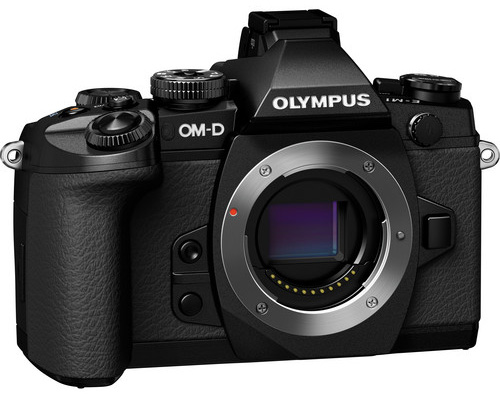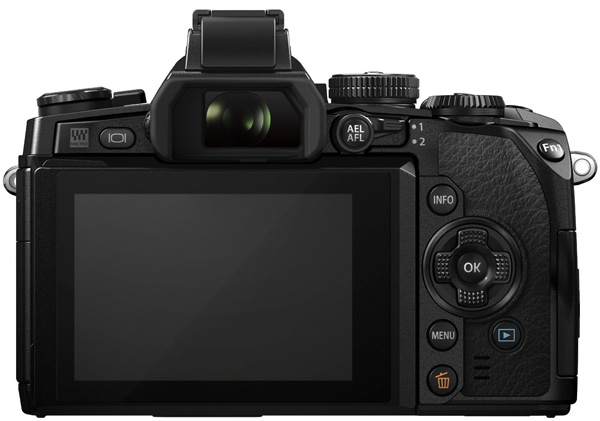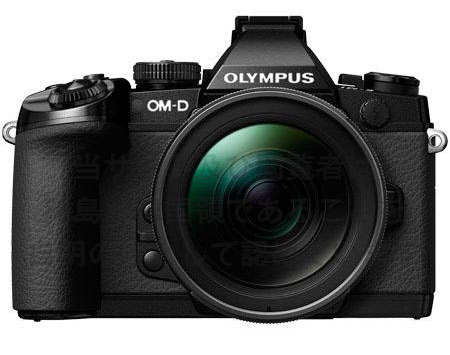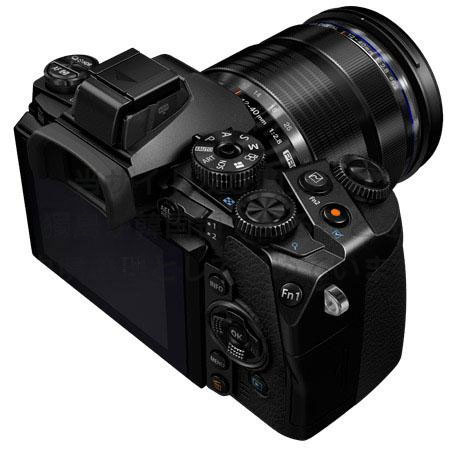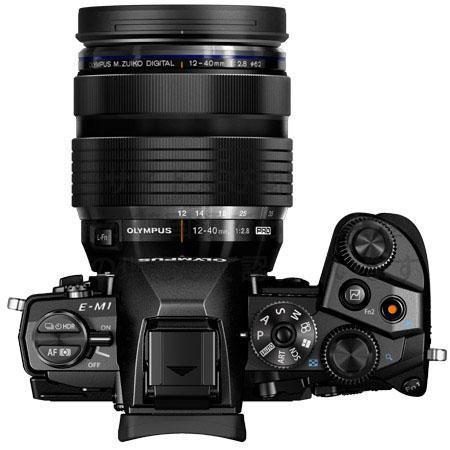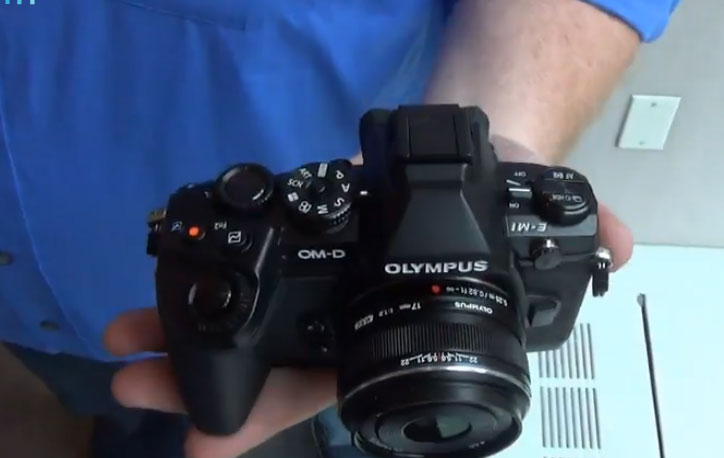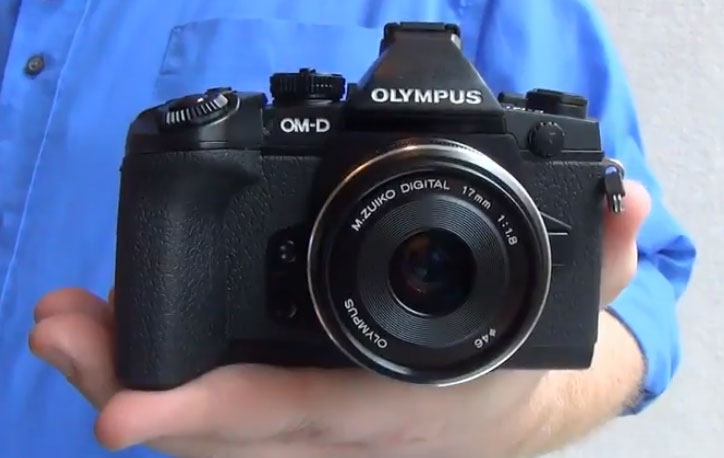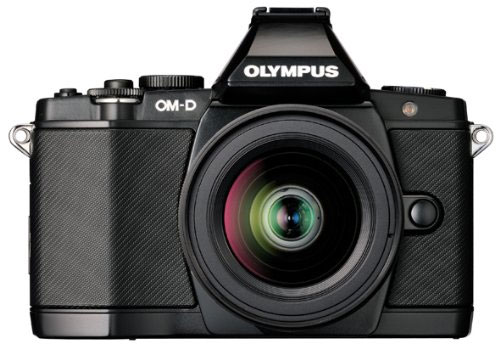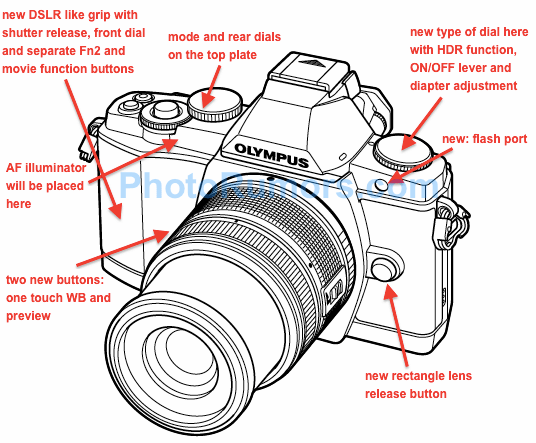The newly announced E-M1 features 16.3 megapixel Live MOS sensor and TruePic VII image processor, dual-mode auto focusing that utilizes both contrast- and on-sensor phase-detection methods to quickly and accurately acquire focus, 5-Axis Image Stabilization compensates for camera movements up to the equivalent of five shutter speed steps, take a look at the major features below
Olympus E-M1 Major features
- 16.3MP Live MOS Sensor
- TruePic VII Image Processor
- Micro Four Thirds System
- FAST Dual Phase- & Contrast-Detection AF
- Interactive 2,360k-Dot EVF
- 3.0″ 1,037k-Dot Tilting LCD Touchscreen
- 5-Axis Image Stabilization with IS Auto
- Built-In Wireless Connectivity
- 10 fps and 1/8000 sec. Top Shutter Speed
- Dust/Splash/Freezeproof Mag. Alloy Body
The Olympus E-M1 features fast TruePic VII Image Processor , the top shutter speed is 1/8000 sec with a mechanical shutter, a continuous shooting rate up to 10 fps with Tracking AF and continuous 6 fps shooting with continuous autofocus, on the rear side we have 2,360k-dot electronic viewfinder and a large 3.0″ 1,037k-dot tilting touchscreen..
Pre-Order / Buy
Olympus E-M1 body at Amazon and BHphoto.
Olympus E-M1 with 12-40mm Lens at Amazon
Olympus E-M1 Sample Videos / Hands-on
Olympus Imaging Corporation (President: Haruo Ogawa) is pleased to announce the upcoming release of the DSLR OLYMPUS OM-D M1, scheduled for release in October 2013. This model features a new Live MOS sensor with On-chip Phase Detection AF, and the new TruePic VII image processor, which achieves Olympus’s best ever image quality in the entire ZUIKO lens system, and is a camera that conforms to the Micro Four Thirds System standard.
Main Features
- The highest-ever Olympus image quality due to a new 16.3 megapixel LiveMOS sensor and new TruePic VII image processor.
- The high-speed, high-precision DUAL FAST AF using both Contrast AF and On-chip Phase Detection AF
- A new EVF system equipped with the latest features that rivals that of full-frame SLR models in both magnification and enhancement of creativity
- In-body 5-Axis Image Stabilization that removes all types of camera shakes
- Reliable dust, splash and freeze proof performance that guarantees operation in environments down to -10°C
Product Summary
| Category | Product Name | MSRP | Launch Date | |
|---|---|---|---|---|
| Interchangeable lens camera that conforms to the Micro Four Thirds standard | OLYMPUS OM-D E-M1 Body(BCL-1580 set) |
Body (black) + Body Cap Lens BCL-1580 |
Open price | Beginning of October 2013 |
| OLYMPUS OM-D E-M1 12-50mm EZ Lens kit |
Body (black) + M.ZUIKO DIGITAL ED 12-50mm f3.5-6.3 EZ |
|||
| OLYMPUS OM-D E-M1 12-40mm f2.8 Lens kit*1 |
Body (black) + M.ZUIKO DIGITAL ED 12-40mm f2.8 PRO |
End of October 2013 | ||
The OLYMPUS OM-D series began in March 2012 with the OLYMPUS OM-D E-M5, with the goal of providing a series that meets existing DSLR user needs. The OM-D’s excellent design, mobility, and system performance received high praise and support from many camera fans for its ability to fully make use of interchangeable lenses even under difficult shooting conditions, and truly perform with viewfinder photography.
The new OLYMPUS OM-D E-M1 is the flagship OM-D model, with even greater image quality and support for both Contrast AF and On-chip Phase Detection AF. These features draw out both the Four Thirds System standard and Micro Four Thirds System standard conformity of the lens to its maximum level.
The newly-developed Live MOS sensor supports Phase Detection AF on the imaging surface. In combination with the newly developed TruePic VII image processor, the camera reduces noise even further at high-sensitivities, and provides excellent image quality with improved reproducibility. Additionally, the newly-developed DUAL FAST AF is also included with optimal selection of Contrast AF and On-chip Phase Detection AF. These enable not only to use the expanded lineup of Micro Four Thirds high-performance fixed-focal length lenses, but also to support comfortable use of Four Thirds lenses with excellent depictive power. By polishing the three elements of image quality (lens, imaging sensor, and image processor), the absolute best image quality in Olympus’s top class DSLR series is achieved.
The built-in EVF, which is indispensable for the compact, high-performance DSLR style that can only be found on an OM-D, features a 0.74x magnification factor (35mm conversion), and a high-resolution 2.36 million dot LCD panel. The automatically adjusted backlight control function provides a view so natural that it will make users think they are looking through an optical viewfinder, and expands the possibilities of EVF performance with the new Color Creator function. The in-body 5-axis image stabilization (compensates for shutter speed by 4 steps*2) has also improved since the OLYMPUS OM-D E-M5 and offers improved image stabilization at lower shutter speeds. The E-M1 surpasses the E-5 in dustproof and splashproof performance, and now boasts low-temperature tolerance with operations guaranteed down to -10, for a high level of reliability appropriate to a flagship model.
The OLYMPUS OM-D E-M1 is the successor model to our professional DSLR E-5, and at the same time it is the new flagship model of our mirrorless system cameras. Full-featured functions drive the rich lens lineup in all directions along with the best in reliability, and compact, lightweight form for the culmination of Olympus efforts.
Main Feature Details
1. The highest-ever Olympus image quality due to a new 16.3 megapixel LiveMOS sensor and new TruePic VII image processor.
Image quality is determined by three components: the lens, imaging sensor, and image processor. To realize the best image quality, advancement of all of these elements as well as attention to detail must be achieved.
1) The new 16.3 megapixel Live MOS sensor that makes On-chip Phase Detection AF possible
37 points Phase detection AF sensor was placed on the imaging sensor surface, and a new 16.0 megapixel Live MOS sensor was included to make DUAL FAST AF possible. The Live MOS sensor and new TruePic VII image processor, improves on decolorization that tended to occur at high sensitivities, as well as providing excellent image quality that has less noise than previous models.
2) New TruePic VII image processor
The Olympus-original image processing technology Fine Detail has evolved into Fine Detail II for proper correction of magnification chromatic aberration that differs depending on each lens’s movement, and applies the appropriate sharpness processing according to the lens type and aperture value for natural, high-quality resolution. The E-M1 is also equipped with moire-removing processing equivalent to that of a low-pass filter, which helps reduce compression artifacts that tend to occur during sudden scene changes when recording a movie.
3) New high-performance lens groups M.ZUIKO PRO and Four Thirds standard
The M.ZUIKO DIGITAL ED 12-40mm f2.8 PRO, which is scheduled for release at the same time as the OLYMPUS OM-D E-M1, is the first model in the new M.ZUIKO PRO category and features dustproof and waterproof performance, toughness, excellent image quality, and high performance. (For details on lens categories, see the main text in the “M.ZUIKO DIGITAL ED 12-40mm f2.8 PRO” release.)
Additionally, DUAL FAST AF mentioned later in this document makes it possible to fully utilize the high-performance Four Thirds System standard lens group that possesses surpassing image quality.
2. The high-speed, high-precision DUAL FAST AF using both Contrast AF and On-chip Phase Detection AF
The newly-developed DUAL FAST AF is an Olympus-original AF system that selects the optimum method depending on the lens and settings; either On-chip Phase Detection AF or Contrast detection AF.
1) 37 point On-chip Phase Detection AF
37 AF targets are located in the On-chip Phase Detection AF method. This enables automatic selection when a Four Thirds System compliant lens optimally designed for Phase Detection AF is attached, and achieves greater precision than the E-5 especially with a bright f2.0 lens, and speed that rivals the Olympus DSLR E-5. Both Small Target, which is excellent for focusing on minute AF points, and Group Target AF which is highly applicable for various situations can be selected.
2) 81 point Contrast detection AF
When a lens is attached that conforms to the Micro Four Thirds standard, the Contrast AF method is automatically selected. While inheriting the fast and accurate AF system of the PEN and OM-D series, AF points have been expanded from 35 to 81. Out of these 81 points, 37 of them are in the same position as Phase Detection AF. In addition to Small Target and Group Target, Super Spot AF can be selected. This enables selection of an even smaller AF point area where pinpoint AF is possible for accurate focusing on very small subjects. This is particularly helpful for specifying a focus location in a small area such as during macro shooting.
3) Combined usage of On-chip Phase Detection AF and Contrast detection AF
When a lens that conforms to the Micro Four Thirds standard is attached and C-AF is selected for subject tracking and continuous AF, On-chip Phase Detection AF and Contrast detection AF are used together. This results in significant improvement of C-AF tracking performance over traditional mirrorless models, with a maximum sequential shooting performance of 6.5 fps.*3
3. A new EVF system equipped with the latest features that rivals that of full-frame SLR models in both screen size and enhancement of creativity
The built-in electronic viewfinder (EVF) has also advanced significantly, for DSLR shooting style that is only available on an OM-D. The E-M1 features a 0.74x (35mm conversion) viewfinder magnification factor that rivals full frame DSLR cameras. The extremely high-resolution 2.36 million dot LCD panel provides a large, clear view that is the equal of optical viewfinders (OVF). With a display time lag of 0.029 seconds, tracking of moving subjects is completely natural. This new Olympus EVF system equipped with many of the latest functions allows users to check what finished images will look like simply by looking through the viewfinder.
1) The adaptive brightness technology
This feature raises the brightness when shooting in bright outdoor conditions, and lowers the brightness in dark indoor conditions, reducing visual errors from light and dark adaptation of the eye. The backlight brightness is automatically adjusted in response to changes in ambient lighting to maintain the proper brightness, and by drawing closer to a view available from OVFs, the EVF provides an environment for easy shooting simulation.
2) LVF Expanded Dynamic Range offering new possibilities for EVF
The HDR shooting mode which automatically generates a single image with an expanded dynamic range from 4 sequentially shot images provides an expanded dynamic range Live View display when shooting. This feature offers new EVF viewfinder possibilities.
3) New function: Color Creator
This feature does not just adjust the hue and color saturation, but allows users to enjoy creating original images that are imbued with their own feeling by actively producing colors. Creative Color is a new creative tool born of a designer’s sensitivity. Fine-tune adjustment of hue and color saturation combinations are available with hue adjustment in 30 steps, and color saturation adjustment in 8 steps including the base line. Color manipulation that was previously difficult to imagine is now possible by following your intuition while using the intuitive GUI and Live View screen.
4. In-body 5-Axis Image Stabilization that removes all types of camera shakes
The 5-Axis Image Stabilization compensates for the shutter speed by 4 steps*2 for correcting camera shake that occurs in all shooting situations from still images to movies. By using new control algorithms, image stabilization at low shutter speeds is more effective than on the E-M5.
1) In-body image stabilization
Among 5-axis camera shake, rolling (optical axis rotation) blur cannot be compensated for on the lens’s image stabilization. A merit of in-body image stabilization is that it can compensate for camera shake with all lenses, including Four Thirds, Micro Four Thirds, and older lenses.
2) IS-AUTO for optimum panning shot
The E-M1 is equipped with IS-AUTO, which automatically detects the camera’s movement, and optimally controls correction depending on the direction of correction, including vertical, horizontal, and angular directions in panning shot. This is not only effective for straight line directions, but also effective for movement in a curved line direction.
3) Checking compensation in the viewfinder
Not only can users check the image stabilization effects in the Live View screen, but they can also check in the same way on the viewfinder. With the stable viewfinder image, accurate framing and focusing is possible even during telephoto or macro shooting.
4) Multi-Motion IS
With a combination of 5-axis image stabilization and Multi-Motion IS, powerful image stabilization is available when shooting movies. With traditional image stabilization, correction of slow, strong camera shake that occurs when walking or breathing was difficult, however, Multi-Motion IS is an effective image stabilization mode specifically for movies.
5. Reliable dustproof, splashproof and freezeproof performance that guarantees operation in environments down to -10
The dustproof and splashproof mechanisms on the E-5 and OM-D E-M5 were regarded as absolutely reliable by many professional photographers. The OM-D E-M1 inherits those characteristics and takes them further by guaranteeing operations down to -10, for the best environmental resistance of any Olympus DSLR. This performance further enhances the reliability of the flagship model by allowing users to shoot in any environment with the absolute best image quality.
1) Dustproof/splashproof/freezeproof construction
Durable magnesium alloy, popular for its rigidity, is used for the entire body, along with highly weather-resistant, special sealing. Additionally, all units were checked for operation at low-temperatures, and guaranteed to continue operating down to -10. By vibrating the traditional dustproof system SSWF (Supersonic Wave Filter) at a super high speed of more than 30,000 times each second, powerful gravitational acceleration is generated to remove dust and dirt. These features contribute to outstanding reliability and mobility so that users can shoot in the most difficult environments, from inclement weather to low temperatures and even dust clouds.
2) Lens system accessories with dustproof/splashproof construction
The standard M.ZUIKO DIGITAL ED 12-40mm f2.8 PRO zoom lens also includes a mount with the same type of sealing as the camera body. The two related accessories, the dustproof/splashproof Power Battery Holder HLD-7 and Four Thirds Adapter MMF-3 also contribute to make the entire system highly impermeable to sand, dust, and water spray. No one else can come close to approaching the mobility of these products in any type of weather.
Other Features
1. Small and light body
High performance and ultra-large EVF viewfinder that surpass DSLR cameras are included on a compact, lightweight body that could not be found on a DSLR. When combined with the compact ZUIKO lens system, comfortable shooting is available anytime and anywhere.
2. 1/8000 sec high-speed shutter and sequential shooting performance
With the 1/8000 sec. high-speed shutter, quick-moving sports shooting is possible, and the maximum aperture value can be enjoyed even under bright daylight conditions. The high depictive performance of the ZUIKO lens system draws out the very best and most appealing aspects of scenes. Additionally, high-speed sequential shooting is available with a maximum frame when using auto focus tracking of 6.5 fps*3, approximately 50 shots in RAW (continuous shooting time approx. 8 sec.).*4 At S-AF sequential shooting, a maximum high-speed sequential shooting frame rate of 10 fps*5, and approximately 41 shots in RAW is available. With rates like these, this model possesses the same high-performance as DSLR cameras.
3. Advanced controls
The large-size grip takes into consideration Four Thirds lenses, and the logical layout of the large buttons makes for excellent controls. Controls are improved with a sure grip, while maintaining dustproof and splashproof performance. The mechanical release switch and large grip similar to the E-5 ensure comfortable continued shooting. From a functional perspective, controls have been improved in various ways such as the settings reset function by pressing and holding the OK button, the toggle option for My Settings shortcut, and the dial lock mechanism to prevent unintentional movement of the mode dial during shooting.
4. 2 x 2 Dial Control
Four often used functions, aperture/shutter speed, exposure compensation, ISO speed, and white balance can now be switched with the lever or two dials. Comfortable controls are maintained while providing customization for an intuitive approach to shooting exactly as photos are envisioned.
5. Built-in Wi-Fi®*6
The OLYMPUS OM-D E-M1 is equipped with a built-in Wi-Fi function. When using the OLYMPUS Image Share (O.I.Share)*7 smartphone app, images can easily be shared, the shutter can be operated wirelessly from a smartphone while viewing the Live View screen, and location information obtained with a smartphone can be added to images on the camera. The remote function has also been improved so that various shooting modes (P, A, S, M, iAUTO) are now available. Users can now wirelessly adjust various settings such as the shutter speed, aperture value, and exposure compensation from a smartphone. The new Live Bulb shooting mode is also available for even greater shooting enjoyment.
6. Art Filter and PHOTO STORY
New variations have been added to the Olympus-original photo expressions, Art Filter and PHOTO STORY. With these features, normal, everyday scenes can be enhanced in various ways with more personality, further expanding photographic possibilities.
1) Creatively paint photos with Art Filter Equipped with 12 Art Filters that fuel the spark of imagination. The new Art Filter variation Diorama II has been added to the OLYMPUS OM-D E-M1. The traditional shooting method in the horizontal position offered only Top and Bottom Blur Effect (Diorama I), but now Left and Right Blur Effect (Diorama II) is available. Not only is Top and Bottom Blur Effect available for vertical shooting, but because Olympus’s Diorama effect gradually strengthens blurring at the focus point of origin, not only can the Diorama effect be enjoyed, but this feature can be used to shoot portraits with a shallow depth of field. Diorama is also newly added to Art Effects and can be used for top and bottom, and left and right blur effects. With a total of 8 Art Effects and a rich variation of Frame Effects, users will never run out of options
2) PHOTO STORY has the ability to add multiple viewpoints to a single scene
PHOTO STORY, which lets users shoot a normal, everyday scene from multiple viewpoints feature the new theme, Speed. User simply slides a finger inside the frame to enjoy sequential shooting via the Touch AF Shutter. With Standard, which offers a rich variety of types and frames, and Fun Frames, which provides three stylish variations for artistic touches, everyday occurrences will become memorable scenes that look just as users imagine them.
7. HDR shooting and Hand-Held Starlight
The E-M1 is equipped with HDR Shooting for 2 different patterns of automatic merging in the camera. With a single press of the shutter button, 4 images with differing exposures are captured and automatically merged into a single HDR image. Artistic HDR images are easy to capture when the HDR Bracketing mode, made possible by the wide 12 EV range, is set. This model also includes the Hand-Held Starlight function which merges 8 images for beautiful images of night scenes with minimal noise. With this feature it is easy to enjoy beautiful night scenes.
8. Advanced Picture Mode
Up to now, e-Portrait could only be used in Scene Mode, and is now available in Picture Mode along with the newly-added Color Creator. RAW processing is still supported in the existing Picture Mode.
9. Focus Peaking
The E-M1 is equipped with the Focus Peaking function for manual focus assistance such as when shooting with an older lens. Border edges appear emphasized in white or black near areas in focus. In combination with In-body Image Stabilization, usability of manual focus lenses is dramatically improved.
10. Interval shooting/Time Lapse Movie
The number of possible shots in Interval Shooting has increased to 999. The recording time length for Time Lapse Movies has increased to 100 seconds.
Olympus E-M1 Specifications
| Camera Type | Micro Four Thirds interchangeable lens system camera |
| Memory | SD Memory Card (SDHC, SDXC, UHS-I, compatible, Eye-Fi Card compatible ) |
| Screen size | 17.3 mm (H) x 13.0 mm (V) |
| Recording format | DCF, DPOF compatible / Exif, PRINT Image Matching III, MPO compatible MOV(MPEG-4AVC/H.264), AVI(Motion JPEG) Wave Format (Stereo linear PCM/16-bit, Sampling frequency 48kHz) |
| File format | RAW (12-bit lossless compression), JPEG, RAW+JPEG, MPO(3D still) |
| Recording image size | [RAW] 4608 x 3456 pixels [JPEG] 4608 x 3456 pixels – 640 x 480 pixels |
| Type | Built-in (Image sensor shift type for movie & still, 5-axis image stabilization) |
| Mode | 4 modes (S-I.S.AUTO,S-I.S.1, S-I.S.2, S-I.S.3), OFF |
| Focal length setting | Yes |
| Lens IS Mode | Yes |
| Available manual focal length setting | Input focal length: 8, 10, 12, 15,16, 18, 21, 24, 28, 30, 35, 40, 48, 50, 55, 65, 70, 75, 80, 85, 90, 100, 105, 120, 135, 150, 180, 200, 210, 250, 300, 350, 400, 500, 600, 800, 1000 |
| Shutter speed range | 60 – 1/8000 sec |
| Finder type | Eye-level electronic viewfinder, approx. 2.36M-dot |
| Eye point / Diopter adjustment range | Approx. 21mm (-1m-1, Distance from rear lens surface) / -4 – +2m-1 |
| Preview | Available with Live Preview function button |
| Level Gauge | 2-axis level gauge; horizontal /vertical |
| Finder Style | Selectable from 3 types |
| Eyecup | Optional eyecup EP-13 is available. |
| Live view | Approx. 100% field of view, Exposure compensation preview, WB adjustment preview, Gradation auto preview, Face detection preview (up to 8 faces), Grid line, Histogram, Magnification display (x5/x7/x10/x14) Off |
| Field of view | Approx. 100% |
| Magnification Ratio | x5, x7, x10 (Default), x14 |
| Display of Face Detection | Max 8 frames of face detection can be displayed |
| Monitor type | 3″ Tilting wide monitor |
| Touch control | Touch shutter release, Touch enlargement, Touch Live Guide, AF area selection, AF area enlargement, Frame advance/backward, Enlargement playback, Touch Super Control Panel, Touch Art Filter menu |
| Tilting angle | Upward tilting angle: up to 80 degrees / Downward tilting angle: up to 50 degrees |
| Brightness / Color temperature control | ±7 levels / ±7 levels |
| AF system | High-speed imager AF (Contrast detection / Phase-difference detection) |
| Focus mode | Single AF (S-AF) / Continuous AF (C-AF) / Manual Focus (MF) / S-AF + MF / AF tracking (C-AF + TR) |
| Full-time AF | Yes |
| Magnified frame AF | Selectable from over 800 AF points Enlarged view check by magnify button (available with old lenses) Magnification x5, x7, x10(Default), x14 selectable |
| Face detection AF / Eye detection AF | Yes / Yes Eye Detection AF mode: Off / Nearer-eye priority / Right-eye priority / Left-eye priority |
| Focusing point | 81-area multiple AF (Contrast detection AF),37-area multiple AF (Phase-difference detection AF) |
| Focusing point selection mode | All target, Group target area (9-area), Single target(Standard Target Size/Small Target Size) |
| AF illuminator | Yes |
| Metering system (TTL Image sensor) | Digital ESP metering (324-area multi pattern metering), Center weighted average metering, Spot metering, Spot metering with highlight control, Spot metering with shadow control |
| Metering range | EV 0 – 20 (at normal temperature, 17mm f2.8, ISO 100) |
| Exposure mode | i Auto, P: Program AE (Program shift can be performed), A: Aperture priority AE, S: Shutter priority AE, M: Manual, Bulb, Time, Scene select AE, Art Filter, Underwater wide / macro |
| Scene select AE | Portrait, e-Portrait, Landscape, Landscape + Portrait, Sport, Night, Night + Portrait, Children, High Key, Low Key, DIS mode, Macro, Nature Macro, Candle, Sunset, Documents, Panorama, Fireworks, Beach & Snow, Fisheye Conv., Wide Conv., Macro Conv., 3D still only |
| ISO sensitivity | AUTO ISO L – 1600(Default), upper limit customize available 200 – 25600 Manual ISO L, 200 – 25600, 1/3 or 1 EV steps selectable |
| Exposure compensation | ±5 EV in 1/3, 1/2, 1 EV steps selectable |
| AE lock | Locked at 1st release of shutter button (can be set to Fn1/Rec button) |
| Metering standard value adjustment | 1/6 EV step, +/- 1EV range |
| Shutter type | Computerized focal-plane shutter |
| Shutter speed | 1/4000 – 60 sec. (1/3, 1/2, or 1EV steps selectable) Bulb/Time: default setting 8min. (1/2/4/8/15/20/25/30 min. selectable) |
| Flash intensity control method | TTL Auto, Auto, Manual, super FP (FP-TTL AUTO, FP-MANUAL) |
| Built-in flash | No |
| Bundled flash | TTL flash, GN=7(ISO100.m) / GN=10 (ISO200.m) |
| Compatible external flash | FL-50R, FL-36R, FL-20, FL-14, FL-300R, FL-600R |
| Color Temperature | 5500±400deg.K |
| External Flash control mode | TTL Auto, Auto, Manual, FP-TTL-AUTO, FP-MANUAL |
| Drive mode | Single-frame shooting, Sequential shooting, Self-timer |
| Sequential shooting maximum speed | [Sequential shooting H mode] 10.0 fps(TBD) in case of “I.S. Off” [Sequential shooting L mode] 6.5 fps(TBD) in case of “I.S. OFF” |
| Exposure bracketing | 2, 3 or 5 frames in 0.3/0.7/1.0EV steps selectable, 7 frames in 0.3/0.7EV steps selectable |
| White balance bracketing | 3 frames in 2, 4, 6 steps selectable in each A-B/G-M axis |
| Flash bracketing | 3 frames in 0.3/0.7/1.0EV step selectable |
| Art Filter bracketing | i-Enhance, Vivid, Natural, Muted, Portrait, Monotone, Custom, Art Filters selectable |
| Bracketing for HDR postprocess | 3 or 5 frames in 2.0/3.0EV steps selectable, 7 frames in 2.0EV steps selectable |
| Mode (Variation / Effect) | Pop Art (I, II / a.b.c.d.e) Soft Focus ( – / c.e) Pale & Light Color (I, II / a.b.c.d) Light Tone ( – / d) Grainy Film (I, II / b.c.d.f.g) Pin Hole (I, II, III / d.) Diorama ( – / d.) Cross Process (I, II / b.c.d.) Gentle Sepia ( – / a.b.c.d.) Dramatic Tone (I / b.c.d.e) (II / b.c.d.e.f.g) Key Line (I, II / a.b.c.d.e.) WaterColor (I, II / a.c.d.) |
| Art Effect | a. Soft Focus Effect b. Pin-Hole Effect c. White Edge Effect d. Frame Effect e. Star Light Effect f. B&W Effect (Yellow, Orange, Red, Green) g. Pict. Tone (Sepia, Blue, Purple, Green) |
| Maximum Recording Time | [MOV] Full HD: Approx. 29min(Normal) / Approx. 22min(Fine) HD: Approx. 29min(Normal) / Approx. 29min(Fine) [AVI] HD: Approx. 7min / SD: Approx. 14min Except for some of the Art Filters Picture with Sound: 30sec. Movie: depend on Movie Recording Time |
| Movie Function | Movie Effect: One shot echo / Multi echo / Art fade Art Filter Movie, Aperture priority Movie, Shutter Priority Movie, Manual Shooting Movie |
| Exposure control (Movie) | P: Program AE, A: Aperture priority AE, S: Shutter speed priority AE, M: Manual, Art Filter |
| Microphone/Speaker | Stereo/Mono |
| Microphone function | Wind Noise Reduction, Recording Volume Audio dubbing possible for still pictures (up to 30 sec.) |
| Aspect Ratio | 4:3(Default) / 3:2 / 16:9 / 1:1 / 3:4 |
| Process | RAW: Aspect ratio is recorded as Exif data, JPEG: JPEG image is produced based on the aspect ratio |
| Detection | 2-axis |
| Magnification | x2 |
| GPS function | Available (by using Smartphone GPS data) |
| Wireless shooting function | Live View, Rec view, Wireless touch AF shutter, Power off Self-Timer setting Camera function is fixed on i-Auto |
| Playback mode | Single-frame, Information display, Index display (4/9/25/100 frames), Calendar, Enlargement (2x – 14x), Movie (with sound, FF/REW/Pause), Picture rotation (auto), Slideshow (with BGM/BGM+Sound/Sound) Slideshow: Still/Movie/Still+Movie, When a camera is connected to HDTV with HDMI cable, 2 new slideshow effect can be selectable.(Still) 1 BGM replaceable. Auto angle correction |
| Information display | Histogram (independent luminance / RGB available), Highlight/Shadow point warning, AF frame, Photographic information, OFF |
| Battery | BLN-1 Li-ion battery (included) |
| Number of recordable pictures | Approx. 330 shots(TBD) [IS ON, CIPA test standard] (with BLN-1 and TOSHIBA super high-speed Class 6 SDHC 4GB card) |
| Dimensions (W x H x D) | 4.8 x 2.7 x 1.5″/ 12.19 x 6.85 x 3.81cm |
| Weight | 430 g / 15.16 oz |

